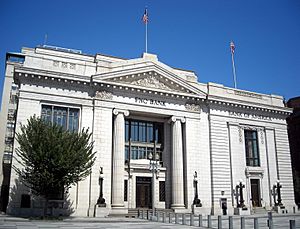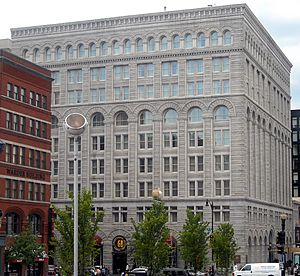Riggs Bank facts for kids
 |
|
| Industry | Banking |
|---|---|
| Fate | Acquired by PNC Financial Services |
| Founded | 1836 |
| Founder | William Wilson Corcoran |
| Defunct | May 13, 2005 |
| Headquarters | Washington, D.C. |
|
Key people
|
Anthony P. Terracciano, Chairman Steven T. Tamburo, CFO |
| Total assets | $6.008 billion (2004) |
| Total equity | $0.317 billion (2004) |
|
Number of employees
|
1,307 (2004) |

Riggs Bank was a bank headquartered in Washington, D.C. For most of its history, it was the largest bank headquartered in that city. On May 13, 2005, after the exposure of several money laundering scandals, the bank was acquired by PNC Financial Services.
The bank was known for handling the personal financial affairs of many U.S. Presidents and many embassies in Washington, D.C. Twenty-three U.S. Presidents or their families banked at Riggs, including Martin Van Buren, John Tyler, Abraham Lincoln, Ulysses S. Grant, Dwight D. Eisenhower, and Richard Nixon. Accounts were also held by Senators Henry Clay, John C. Calhoun and Daniel Webster, Confederate president Jefferson Davis, American Red Cross founder Clara Barton, suffragist Susan B. Anthony, and generals William Tecumseh Sherman and Douglas MacArthur.
The bank billed itself as "the most important bank in the most important city in the world".
The bank was investigated for several money laundering scandals, including going to great lengths to allow former Chilean dictator Augusto Pinochet to hide his fortune after his accounts were subjected to asset freezing and for unknowingly allowing the hijackers involved in the September 11 attacks to transfer money due to lax controls at the bank.
History
In 1836, William Wilson Corcoran opened a small brokerage house. In 1840, Corcoran and George Washington Riggs, the son of Elisha Riggs, a neighbor, formed "Corcoran & Riggs", which offered checking and depositing services.
In 1844, the U.S. government allowed Corcoran & Riggs to be the only federal depository in Washington, significantly increasing business.
In 1845, Corcoran & Riggs financed Samuel Morse's invention of the telegraph and moved into a new headquarters at 1503–1505 Pennsylvania Avenue NW, directly across the street from the United States Department of the Treasury.
In 1847, the bank lent $16 million to the U.S. government to pay for the Mexican–American War.
In 1854, Corcoran retired and George Washington Riggs re-assumed leadership. The bank changed its name to "Riggs & Company".
In 1868, the bank provided $7.2 million in gold towards the purchase of Alaska.
In the 1860s, the bank financed Robert Peary's first expedition to the North Pole and the expansion of the United States Capitol.
In 1881, George Washington Riggs died.
In 1891, the new Riggs Bank building in Washington was opened, built in the Richardsonian Romanesque style.
In 1896, after accepting a government charter, "Riggs National Bank" was formed and Charles C. Glover was named president. In 1898, Lawrason Riggs resigned from the board of directors, ending the involvement of the Riggs family in the bank.
In 1909, the president of the bank presented to the United States Congress an economic plan that resulted in the establishment of the Federal Reserve in 1913.
During World War I, the bank participated in a Liberty bond drive. In the 1920s, the bank established a new savings deposit system as a result of the large deposit boom. During the Great Depression, Riggs director Robert V. Fleming acted as adviser to President Franklin D. Roosevelt.
In 1922, the bank acquired Hamilton Savings Bank and opened a branch in Dupont Circle. The bank also constructed the Riggs-Tompkins Building, which was at the time the largest building in Columbia Heights.
In 1925, it acquired Northwest National Bank, in 1928, it acquired Farmers and Mechanics National Bank, which included William Marbury on its board of directors. In 1933, Riggs acquired a portion of the assets of Chevy Chase Savings Bank.
Beginning in the early 20th century, the bank embarked on a successful project to attract embassies and diplomats as customers and by 1950 most embassies in Washington were customers of the bank.
In the 1950s, the bank opened an office at Walter Reed Hospital.
In 1954, Riggs acquired Washington Loan and Trust and in 1958, it acquired Lincoln National Bank.
In 1981, Joe Allbritton acquired a controlling interest in the bank and became chairman.
In 1983, as a result of the change in control, several executives, including chairman Vincent C. Burke, resigned.
In 1986, the bank expanded into Northern Virginia with the acquisition of Guaranty Bank and Trust Company for $37.8 million.
In 1990, the bank acquired The Bank of Washington.
In 1993, Joe Allbritton resigned as chief executive officer of the bank after it suffered during the savings and loan crisis.
On May 13, 2005, after the exposure of several money laundering scandals, the bank was acquired by PNC Financial Services.
See also
 In Spanish: Riggs Bank para niños
In Spanish: Riggs Bank para niños


